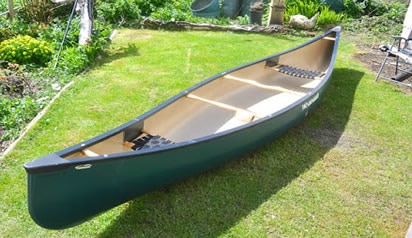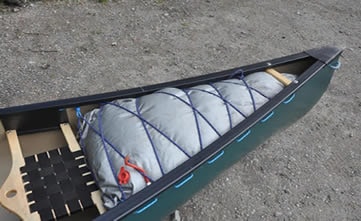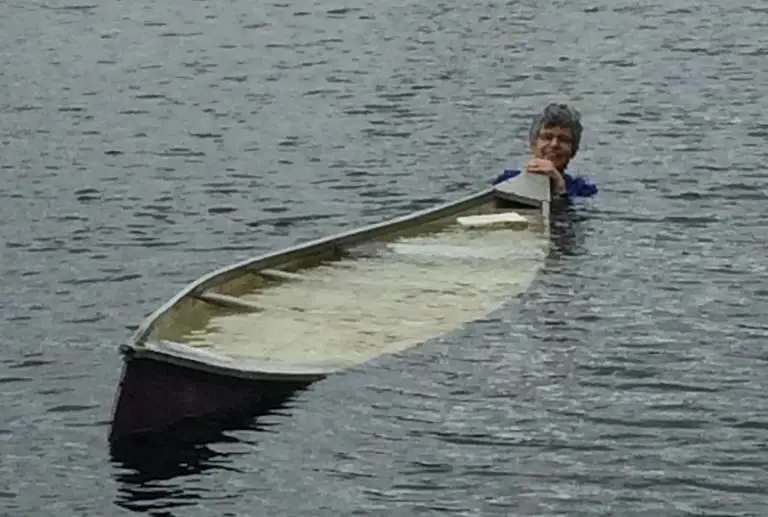A canoe, like any boat, can sink. When it is used in whitewater rivers with rapids and in very turbulent water for which it was not designed a traditional canoe will most likely take on water and sink. Many canoes are naturally buoyant enough to avoid sinking completely though. Adding flotation aids, placed at the stern and bow, will stop any canoe from fully submerging under the water, keeping it afloat just below the waterline but not all canoes are fitted with these buoyancy devices.
Contents
Will a canoe sink if filled with water?
A canoe is like any other boat; if it takes on too much water it is going to become submerged under the waterline. Does this mean it will sink to the bottom of the river or lake? Not necessarily. It depends on the canoe and the modifications it has.
Many canoes, especially those rented out for day trips and recreational purposes, will have flotation aids added to them at the bow and stern. These canoes will not completely sink even if filled if water. Canoes not fitted with these flotation aids may completely sink depending on the material they are made from.
These flotation aids come in a variety of different forms. The aim is to add some buoyant material to the interior of the boat so that it will not sink completely to the bottom but will have enough buoyancy to stay afloat just below the waterline.
These flotation aids act to keep the boat afloat just under the waterline for two reasons:
- The boat can then be used as a sort of life raft so the canoeists can hold onto it until help arrives.
- The canoe will be easier to retrieve.
Flotation aids
Flotation aids usually come in the form of simply airbags that are packed into the stern and bow area of the canoe.
Most canoes are sold without flotation aids as this is a modification made by the boat owner when outfitting the canoe.

However, adding flotation aids to a canoe is incredibly simple.
All you have to do is pack the airbags, or similar buoyant aids, into both the bow and stern areas of the canoe near the tipped ends of the boat. These bags are lashed down with marine grade rope and then secured to the bottom of the boat using a D-strap. We show you how to do this here.
Canoe flotation bags are sold in a shape that allows the bag to fit neatly into the canoe.

When the canoe starts to take on water and begins to sink these flotation aids will stop it from becoming fully submerged, and sinking to the bottom of the river or lake, because they keep both ends of the boat buoyant enough to stay close to the waterline.
Flotation aids, like airbags, are a very effective way of keeping your canoe from fully sinking and most canoeists will add them to their boats.
Some boats come with flotation aids installed as standard. Many aluminum canoes, which I do not advise using if you portage, will have flotation tanks that act in the same way as airbags. Grumman put flotation devices in their aluminum canoes.
The disadvantage of these tanks is that if one gets a hole in it, it becomes completely useless and the boat will sink almost upright in the water. If both tanks fail then the boat will likely sink to the bottom a aluminum is quite heavy.
Of course boats made from lighter materials, such as marine plywood (used in a home built canoe) or Kevlar, may not completely sink at all with or without flotation aids. However, the more weight you add to the canoe in the form of gear and equipment etc., the more likely it will be to sink if it is not fitted with flotation aids.
For example, imagine what would happen to a freighter canoe with a full 3 ton load if it took on water. Do you think it would float without flotation aids? Not likely! 3 tons is a big load.
What can sink a canoe?
Anything that can sink a boat can sink a canoe.
Although you can fit outriggers to a canoe to help with stability, canoes are not designed for very turbulent waters. If you take a canoe onto very rough whitewater it will likely take on water and begin to sink.
In very turbulent water the canoe may sink even if it has flotation aids installed especially in obstacle-laden rivers.
If you try to use a canoe in the type of rapids that kayaks, rafts and drift boats run, then don’t expect to get your boat back in one piece if at all.
Bear in mind that damaged flotation aids are useless. If your flotation tank, pod or airbag is damaged then it will not stop your canoe from sinking. Check your flotation aids regularly.
How to avoid a canoe sinking
Many canoe owners will take their boat to a calm lake or river that is fairly shallow and deliberately tip it so it fills with water. They do this to see how buoyant the canoe is and if it will stay afloat just under the waterline before they take it into more troubled waters.
Obviously this approach to testing your canoe’s natural buoyancy is only a viable option if you have an appropriate retrieval system in place – this usually comes in the form of several friends hauling the boat out of the water.
Unless you really need the additional space, for long duration boat camping equipment for example, I highly recommend you add airbags, or some similar buoyancy aid, to your boat at the stern and bow areas. This gives you piece of mind and will take an hour or two to complete at most.
Check your buoyancy aids are undamaged before every trip. Even a minute hole in an airbag renders it useless. As these airbags and cheap and easy to replace it is a good idea to keep at least one spare just in case.
Summary
A canoe is just like any other boat and can sink, though many canoes are naturally buoyant enough to stay afloat just below the waterline. The buoyancy of your canoe will depend on the material it is made of.
Adding flotation aids to the stern and bow areas inside the boat almost guarantees your canoe will not fully sink to the bottom if it is submerged.
Although some canoes are sold with flotation aids already in them, such as aluminum canoes, most flotation aids are added by the boat owner and come in the form of simple airbags secured to the interior of the bow and stern by ropes and D-straps.
Flotation aids are only effective if they are undamaged. Check them regularly.

